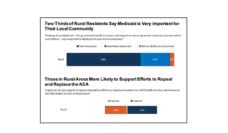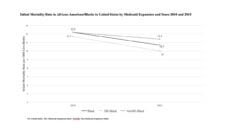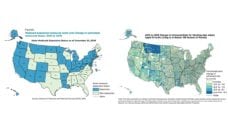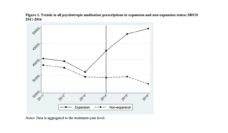Among all forms of health insurance, Medicaid stands alone in its strength, its ability to evolve in response to emerging public health needs, and its resilience. Over more than five decades, Medicaid has become the nation’s largest public health program and one of its most indispensable. Today Medicaid finances half of all births and, along with its small companion the Children’s Health Insurance Program, 40% of all pediatric care. Medicaid is the means by which the nation has created community-based long-term services and supported children and adults with advanced health needs. Indeed, deinstitutionalization could not have happened without it.
Medicaid is how we pay for treatment for uninsured patients diagnosed with breast or cervical cancer. It is the single most important funder of treatment for people living with HIV/AIDS and the largest funder of health care safety net clinics and hospitals that anchor health care in the poorest communities. In times of public health disaster, whether naturally-occurring or man-made, the nation turns to Medicaid. It has, for example, been the go-to source for funding the range of health treatments needed to combat the opioid epidemic.
Over a half century, these and more responsibilities have been assigned to a program that, in its original state, was understood as a companion to Medicare, a pathway for covering a modest number of public assistance beneficiaries. In 1965, few could have foreseen Medicaid’s ultimate potential as a centerpiece of public health, owing to its ability to finance health care for populations and conditions excluded from both Medicare and the market norms of a voluntary insurance system.
Two factors account for Medicaid’s remarkable growth. First, unlike other forms of insurance, Medicaid financing rests on general federal, state, and local revenues coupled with broad-based provider taxes. Because Medicaid is not tied to premium contributions or payroll taxes, its reach is not limited by narrow funding structures that inevitably constrain program design and growth.
Its services—provided virtually free with only nominal cost-sharing—span the entire life-cycle, from pregnancy and birth through long-term care.
Second, unlike private insurance or Medicare, Medicaid is designed to embrace risk rather than avoid it. From enactment, its beneficiaries have been the poorest and most medically vulnerable people. Its services—provided virtually free with only nominal cost-sharing—span the entire life-cycle, from pregnancy and birth through long-term care. Enrollment happens in community settings and at the point of care—something unheard of in insurance markets. Medicaid does not use waiting periods, and eligibility can be established retroactively in order to cover incurred costs.
Because of Medicaid’s unique financing and structure, the program has become the solution of choice for policymakers on a host of public health priorities such as coverage for low-income children and pregnant women, creating an insurance pathway for low-income working parents without affordable workplace coverage, and community based services for children and adults with serious and lifelong disabilities. Most of this growth has come, not as top-down federal commands, but as state innovations under federal legislative options. When it finally came time to insure the nation’s poorest working age adults, it should surprise no one that, rather than relying on a restructured yet fragile individual insurance market, Congress chose to expand Medicaid (the hardy perennial rather than the hothouse flower).
Yet Medicaid’s flexibility and responsiveness have also triggered a deep challenge owing to its sheer size.
A veritable deluge of studies over decades have built an unusually strong evidence base for the program. Yet Medicaid’s flexibility and responsiveness have also triggered a deep challenge owing to its sheer size.
By 1967 policymakers, already aware of what they had unleashed, began to apply the brakes. The first legislative effort to cap overall Medicaid spending came in 1981, the first year of the Reagan presidency. Nearly 40 years ago, the effort to end Medicaid failed, as the program’s importance to the health care system was becoming clear for all to see. Since then, Medicaid has endured two more near-misses: first, during the 1995 Gingrich revolution that most famously produced welfare reform, and in 2017 when the program’s survival became a centerpiece of the battle over “repeal and replace.”
The summer of 2017 witnessed a war worthy of Game of Thrones, with the stakes being not simply the Affordable Care Act’s adult Medicaid expansion but the entire program. Ultimately the repeal effort toppled. In good part, this collapse could be traced to the implacable opposition to the Medicaid provisions by the nation’s Governors, who understood better than anyone the degree to which Medicaid—insurer of 75 million people—has become the foundation on which the health system rests.
Medicaid needs progressive reforms that emphasize innovation in care delivery and increased efficiencies.
Medicaid survived 2017. Still, it faces many challenges. Seventeen states remain outside the ACA adult expansion, leaving millions with no pathway to affordable health insurance. Perhaps the 2018 mid-term state election results will begin to change this, as was the case for Virginia in 2017. For all states, Medicaid’s sheer size and budgetary demands represent an ongoing challenge, even as Medicaid revenue helps fuel state economies.
Medicaid needs progressive reforms that emphasize innovation in care delivery and increased efficiencies. We need to couple these reforms with a broader public health strategy aimed at integrating Medicaid services with health and social interventions aimed at addressing the root causes of poor health. The consequence of failure likely will be more legislative attacks—apparently a post-midterm-election priority for Republican Senate leaders—or, as we are now witnessing, efforts to drive away the poor through work “experiments” or immigration “reforms” designed to punish the poor rather than advance the public health and welfare.
Feature image: Arwen Twinkle, Peony-2, used under CC BY-NC-ND 2.0
















